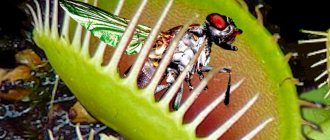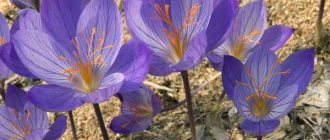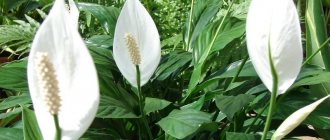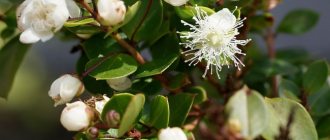The article was prepared by a specialist for informational purposes only. We urge you not to self-medicate. When the first symptoms appear, consult a doctor.
Passion flower is a genus of plants belonging to the passionflower family, of which there are more than 500 species in nature. Synonyms for passionflower are names such as passionflower and cavalier's star. Passion flower prefers subtropical and tropical climates, grows in America, Peru, Brazil, Australia, Asia, and is found in Transcaucasia.
The plant can be represented by both annual and perennial grass, as well as climbing shrubs. The leaves are lobed or entire. Passion flowers are large, most often very fragrant, have a bright color and five petals. The leaves and petioles of most plants of this species have glands that produce a liquid to attract ants in order to repel caterpillars, which are the main pests of passionflower. Moreover, the glands of different types of flowers are located differently. The plant evolves, which is proven by the fact that some flowers have learned to form outgrowths similar to butterfly eggs to scare them away. Seeing an already occupied flower, the butterfly does not land on it.
The passion flower was first described quite fully in 1553 by P. S. de Leon, who called the flowers granadillas, which literally means small pomegranates. Interestingly, there is an opinion that the passion flower is the embodiment of the suffering of Christ. Thus, its three stigmas are compared to the nails that nailed the limbs of Jesus to the cross, the crown symbolizes the crown of thorns, and the stamens are five wounds. Moreover, these are not all the religious symbols that people have found in this plant.
What is passionflower, what does it look like: photos, signs and superstitions
The flower called “passionflower” is very unusual and rare. It is distinguished by incredibly beautiful flowering. It is not uncommon for a plant to have other, more well-known names:
- Passionflower
- Cavalier star
Passionflower has a smooth stem and can curl. The average plant length is ten meters . The leaves of the plant have an interesting color: they are green on top and gray below.
Passionflower blooms with fairly large flowers. Flowering has shades of purple, red and light white. In addition, the plant may have fruits that are no larger than an egg. Passionflower blooms throughout the summer ; the flowers die off only in the fall.
The name of the plant has a very interesting history. The word “passionflower” itself consists of two Latin words:
- "passio" - to suffer, suffering, suffering
- "flos" - bloom, flowers
Passion flower Passion fruit - passion fruit
The name of the plant was given in ancient times by missionaries traveling around the world and arriving in South America. It was to them that this flower seemed very symbolic, reminding them of the suffering of Christ.
themselves are very large, reaching ten centimeters in diameter. They are star shaped . Their color is bright and unusual, has many color shades. Flowers grow on long stalks.
The passionflower flower has five petals. That is why he is often compared to Christ, arguing that he had five wounds. In addition, the flower has exactly five sepals. Each bud and flower has an ovary , which contains three stigmas. There are also exactly five stamens around the stigmas.
Variety of passionflower flowers
Passionflower flowers have a very pleasant sweet aroma . Picking flowers will not allow them to remain fresh for a long time; they quickly wither.
There is a certain “language of flowers” that represents passionflower as a flower of respect and fidelity. That is why, if a man gives a woman passionflower, he promises her a long, strong relationship imbued with trust and sensuality.
Useful and medicinal properties of passionflower
Passionflower is very beneficial for the body because it contains:
- vitamins of groups: A, B, C, E and PP;
- minerals: magnesium, iodine, calcium, phosphorus, etc.;
- acids: formic, butyric, myristic, malic and palmitic.
The plant is actively used in traditional and alternative medicine. From shoots up to 0.6 m, developed buds and tops, various teas, alcoholic tinctures and herbal preparations are made.
It has strong sedative, anti-inflammatory, antifungal and analgesic properties. It relaxes the central nervous system, calms the nerves, relieves insomnia, headaches and stress. In addition, preparations based on passionflower stabilize hormonal levels and restore the immune system, and also prevent asthmatic attacks.
Passion fruits.
Types of passionflower, what does the flower look like?
The most basic types of plants:
- Edible passionflower. Grows mainly in South America. Many delicious sweet drinks and desserts are prepared from the fruits of the plant. The world knows the fruit of the edible passionflower as passion fruit.
- Blue passionflower is a climbing vine with a strong stem and single flowers, quite large, blue in color. The plant has a large orange fruit.
- Passionflower is the most delicate - it has large flowers of pink shades with a diameter of up to 12 centimeters. This type of plant is distinguished by large fruits.
- Laurel-leaved passionflower - has characteristic leaves similar to a bay leaf.
- Passiflora incarnata - the plant has purple petals and bright yellow fruits.
- Passiflora graceate - has white flowers with green foliage. Flowers with a slot. The fruits have a bright red color.
- Passiflora three-stripe - has three characteristic stripes on the leaves. The flower stems are ribbed. This passionflower has pale yellow flowers and bluish-gray fruit. A distinctive feature of this plant is the lilac aroma it gives.
- The tetrahedral passionflower is the largest passionflower, reaching 15 meters in length. The flower is large, 15 centimeters in diameter. The fruits are oval with a very dense peel, edible.
Edible passionflower
Blue passionflower
The most delicate passionflower
Laurel leaf passionflower
Passiflora incarnata
Passiflora graciiformes
Passiflora three-striped
Passiflora tetrahedral
Description of the plant
The indoor vines of the passionflower genus include more than 500 varieties and species. The heat-loving plant naturally grows well in the southern latitudes of Brazil, Madagascar and Australia. It is used to decorate gardens and verandas in Asian countries. In Russia and Europe it is grown only indoors.
Most of the indoor plant species are evergreen vines and shrubs. The remaining forms of passionflower are perennial and annual herbs. It is distinguished by dark green leaves that are dense to the touch, located on a thin stem. The branches can reach 9 m in length. Large and beautiful flowers are shaped like a star with sharp rays and open up to 15 cm in diameter.
The flower has an unusual shape and structure: the base consists of 5 sepals, large petals and bracts. Stigmas with pollen grow in the center of the passionflower. The active appearance and flowering of buds begins in the first half of July and ends in September with proper care.
A distinctive feature of passionflower is that after opening the bud pleases the eye for no more than a day. But on each branch, with careful care, many buds bloom. The shade depends on the variety; it can be pink, lilac, blue or purple. Seeds and fruits ripen in October.
Important! Many passionflower varieties produce edible passion fruit with a pleasant taste and aroma.
Passionflower: growing from seeds at home
Those who want to grow passionflower from seeds should be aware that their germination rate at home is very low. In particular, the actual collected seeds can germinate only in 30% of cases . And if you have stored the seeds for a whole year, then they can germinate only 2% of the time.
Seeds should be sown in late winter or early spring. Before planting seeds, they should be rubbed with sandpaper, breaking the hard, natural shell. Another condition is to pre- soak the seeds in warm water for two days.
IMPORTANT: If the seeds float after soaking, they should be collected and thrown away as they are no longer viable.
Growing passionflower from seeds
Plant the seeds in small plastic cups or containers . The top of the container must be covered with glass. You can also replace glass with cling film. Seeds should be grown in diffused sunlight at a temperature not exceeding 25 degrees.
When the seeds sprout, the glass is removed and additional light is provided . Daylight hours for sprouts should last about twenty hours. It is necessary to pick the sprout only when the first pair of leaves appears on it.
After this, the seedlings go deeper into the soil, preserving the earthen lump that will remain on the roots. There is no need to deepen the sprout too much. Keep in mind that growing passionflower is a long process.
IMPORTANT: You can wait several months for the sunrise itself, and up to eight years for passionflower to bloom.
Diseases and pests of passionflower
In winter and autumn, excess moisture leads to the development of fungal diseases, which appear as spots on the leaves, after which they wither or die. For prevention purposes, such passionflower is treated with fungicides.
If watered incorrectly, rotting of the roots may occur. In this case, the entire system is cut off and re-rooting is performed. If rotting is observed on the trunk, then healthy shoots are cut off and cuttings are made.
Passionflower leaves are attractive to aphids, scale insects and scale insects. The presence of pests is symbolized by: slow growth of flowers, their pale color and abundant shedding of foliage. You can get rid of them using a soap solution or insecticides.
Passionflower: home care
Properly caring for passionflower at home is very difficult, but doable . The plant requires a lot of attention. First of all, the flower “requires” a lot of light. Place passionflower on the windowsill of a “southern” window.
If you have the opportunity, in the summer, give the flower the opportunity to spend the maximum amount of time outdoors : in the yard, on the balcony. Passionflower “does not like” musty and stagnant room air. The flower may also “suffer” from drafts or temperature changes.
Too hot temperatures are also not favorable for passionflower. In the flower room, the temperature should not exceed 30 degrees C. In winter, the plant “rests”; it requires a temperature of at least 12 degrees.
The flower needs regular watering . Moreover, the peculiarity of this flower is that it should be moistened without waiting for the soil to dry out. However, excess water remaining in the trays should be drained regularly. The plant “loves” moist air, which can be created with regular spraying.
IMPORTANT: In hot weather, the flower can be “bathed”, but this must be done very carefully so as not to damage the delicate stems of the plant.
Passionflower at home
Important features of flower care:
- Passionflower needs annual pruning
- Pruning can encourage the plant to branch and grow.
- Secondary shoots should be pruned, as flowers grow only on young shoots.
- Bald shoots also need pruning
- Pruning should only be done on plants that are three years old.
- The plant should be periodically fed with organic matter.
- Passionflower should be fed from February to September.
- You should “feed” the plant no more than once every two weeks.
- Foliar feeding should be done once every six weeks.
- Passionflower should not be fertilized if the plant is “sick” with something or “suffers” from moving to a new place.
- Abundant flowering of passionflower is guaranteed only by a sufficient period of “rest”.
- Passionflower “rests” in a bright room with fresh air.
- During “rest”, passionflower does not need to be sprayed ; watering is reduced.
- A young plant should be replanted every year, and an adult plant once every three years.
- Choose a small pot ; in a large pot, the plant will spend a lot of time putting out leaves.
- The soil for passionflower should consist of sand, turf soil, and peat soil. Each component must be in equal parts.
IMPORTANT: Regularly ensure that the plant grows “comfortably”. To do this, direct the growth of the flower stems in the direction you need and most conveniently. Make sure that the plant has strong support.
Growing passionflower at home
Transfer
Young plants are transplanted into a new pot every year, and adults - once every 2-3 years. The pot is selected small. The new container should be only a couple of centimeters larger than the previous one. Otherwise, the plant will grow roots and greenery, and you will have to wait a long time for flowering.
Soil for passionflower can be bought in a store or mixed yourself from the following ingredients:
- peat soil;
- leaf soil;
- turf land;
- sand.
All components are taken in equal parts and mixed. A layer of drainage is poured onto the bottom of the new pot, then a layer of soil, onto which the bush is carefully placed along with a lump of earth. The roots around and above are covered with soil and watered with water at room temperature.
Attention! During flowering, passionflower cannot be moved from place to place, otherwise it will drop its buds!
Why do passionflower leaves turn yellow?
The dormant period of passionflower has several features:
- The stem may become stiff
- The plant may shed its leaves
- The leaves of the plant may turn yellow and fall off
If the plant is not in a dormant period, the plants may turn yellow for several reasons:
- The flower stands in a draft
- The flower does not have enough light, move it to a brighter windowsill.
- The flower lacks moisture
- The flower doesn't have enough watering
- The plant is sick
- The flower does not have the right soil
What can harm passionflower:
- The plant may be affected by spider mites
- The flower can be eaten by aphids or thrips
- Mealyworms or whiteflies may appear in the soil
IMPORTANT: Any pest in a flower “requires” immediate destruction. The plant should be treated with products containing cypermethrin . If the plant is affected by rot, then most likely it will not be possible to get rid of it completely.
Flowering passionflower at home
Problems during cultivation
Caring for passionflower requires following all the rules, otherwise you may encounter some problems.
Passionflower doesn't bloom
The flower needs a period of rest, during which it gains strength to bloom. When grown in winter in warm home conditions, flowering may be sparse or absent altogether. Also, if the passion flower does not bloom, you should pay attention to the following points:
- is the lighting good?
- does the plant have enough moisture and nutrition;
- Excess nitrogen in fertilizers leads to foliage growth, and buds may not form.
Passiflora leaves turn yellow
The yellow leaves of the plant should first be inspected for the presence of pests. Dry air in the apartment and other unfavorable conditions can cause spider mites, whiteflies, mealybugs and thrips to appear on the vine. They all feed on the sap of the plant, as a result of which the leaves first turn yellow, then dry out and fly off. Pests can be destroyed by treating with special insecticidal preparations.
Other causes of yellowing leaves include:
- insufficient lighting;
- lack of microelements;
- excess moisture, in which yellow spots first appear on the leaves.
Don't worry if the old lower leaves turn yellow and fall off on an adult bush. This is a natural process.
The tips of passionflower leaves dry out and darken
This means that there is low air humidity in the room, which causes the plant to suffer. In such conditions, it requires regular spraying.
However, the leaves may darken due to dry or waterlogged soil. If darkened leaves begin to fall off rapidly, care should be reconsidered.
Droplets on the leaves
A natural feature of the vine is the appearance of sweet nectar in the form of droplets at the base of the leaves. But it can be released abundantly if the room is stuffy and hot or the pot is in the sun, which causes the soil to overheat.
Passionflower sheds buds
During the flowering period, the plant does not like change, so improper watering, drafts, lower air temperatures and moving the pot to another place can cause the buds to drop.
The second reason why passionflower drops its buds is a lack of light and nutrition.
Why does passionflower not bloom: what to do, how to make passionflower bloom?
You can wait a very long time for passionflower to bloom. When planting seeds, you can wait up to eight years for the first flowers. However, the following methods will help you make” passionflower bloom
- Regular humidification in the morning and evening
- Sufficient amount of light , additional lighting.
- The plant should be planted in a small pot ; the plant will pay attention to putting out leaves.
- Fertilizers should not be used sparingly ; do this no more than twice a month.
IMPORTANT: The most important condition for the wild flowering of passionflower is a complete rest period for the plant in the winter.
Why does passionflower get sick?
Ways to Use Passion Flower
Passion flower is used as a tincture. This will require a liter of 60% alcohol and 200 g of dry herb. You need to infuse the medicine for 14 days, shaking the container periodically. The resulting tincture is used depending on the therapeutic purpose. The average dose is 30-40 drops, you need to take the product 3 times a day.
You can use passionflower in a variety of preparations. For example, with lemon balm, mint, anise, valerian root. Passion flower is taken in a volume of 20 g, anise in a volume of 15 g, valerian in a volume of 25 g, and the remaining herbs in a volume of 10 g. The herbs are brewed with 400 ml of boiling water and infused. As a sedative, you can use the infusion 3 times a day, 50 ml.
You can brew passionflower herb as tea. It is taken as a sedative. To prepare the drink, you need to take a teaspoon of dry raw materials, pour 100 ml of boiling water and leave for 10 minutes. Then strain the resulting mixture and use it as a regular brew, drinking a cup of tea before bed. This will normalize night rest and relieve indigestion if it is caused by neuroses.
Passiflora, how does it reproduce?
Passionflower reproduces in two ways:
- Seeds
- Cuttings
Replanting a plant with seeds is much more difficult , since the seeds may become unusable during the storage period. Propagation of passionflower by cuttings is a long and careful process, since the sprouts need proper care :
- Additional lighting
- Greenhouse effect
- Exact soil ratio
- It’s good to add charcoal to the soil
- Sufficient fresh air indoors
Propagation of passionflower by cuttings
Use in landscape design
A tropical guest can bring the atmosphere of the Mediterranean or exotic tropics to the garden. The liana is used to decorate gazebos and pergolas; plantings in a composition with terry calistegia look especially impressive.
An overgrown vine can decorate buildings and fences. I use heat-loving varieties in potted gardening, placing them on the terrace or near the entrance to the house.
After flowering, the vine's dense green foliage contrasts favorably with bright roses, blue hyssop or karyopteris, colorful penstemon and summer flowers.
How to root passionflower with cuttings?
Rooting by cuttings:
- Passionflower propagates by cuttings. Plant shoots should be cut only from young shoots that form in the spring.
- Each detached cutting must have at least two leaves and a growing point.
- If you are cutting a shoot, the lower part of the leaves should be removed.
- For planting, you should prepare a plastic cup with holes made in the bottom and drainage placed in it.
- Soil from chernozem and turf soil is placed on top of the drainage in a one to one ratio.
- The soil should be moistened and a greenhouse should be made using glass or cling film.
- Rooting of cuttings should take place at a temperature not lower than 20 degrees.
- Glass or film is removed only after three weeks
- Strengthening the cuttings can last up to three months
Care errors. What to do to correct the situation
| Problems | Causes | Solutions |
| The tips of the leaves turn brown | Too dry air, reduce watering. | Set air humidity control. Bring watering to the recommended rate. |
| The leaves acquire a soft consistency and curl | The temperature regime is violated. Low temperature. | Bring the temperature to normal. |
| Leaves turn yellow and fall off | Insufficient watering. Low temperature. | Bring indicators in accordance with requirements. |
| Slow development of the vine | Lack of nutrition. | Fertilizing with complex fertilizers. |
| Thinning leaves and shoots | Violation of light and temperature conditions. | Check the lighting. Increase the amount of nutrients. |
| The base of the stem rots | Excessive watering. | Check drainage efficiency and reduce watering. |
| Passionflower doesn't bloom | Diseases and various types of pests. | Prevention and timely disposal of diseases and insects. |
Indications for use
The beneficial properties of the plant are used for treatment, maintaining health, and improving appearance in cosmetology. Passion flower is often used in dietary supplements. Indications for the use of dietary supplements:
- high blood pressure or changes therein;
- nervous disorders, increased anxiety, frequent stress;
- cardiovascular pathologies;
- rheumatism, joint pain;
- chronic alcoholism, drug addiction, long history of smoking;
- convulsions;
- hormonal disorders;
- insomnia.
A lasting positive result can be achieved with a course of taking dietary supplements.
For whom is passionflower contraindicated?
A strict contraindication is an individual hypersensitivity reaction. When used topically, the oil is known to cause skin irritation in some people. Some people may be allergic to plants from the genus Passiflora, so they should avoid such products in any form.
In general, relatively little information is available about the safety of passionflower as a cosmetic ingredient. Its oil should not be taken orally as it can be toxic even in low concentrations.
We recommend reading: Medicinal properties and contraindications of wild strawberry leaves
Before using this oil, you should do a patch test on a small area of your skin. If irritation does not occur, you can confidently apply this oil directly to the skin, even undiluted. However, for problems such as psoriasis and eczema, this product is not recommended for use.
Although passionflower oil is sometimes marketed as an anti-acne product, there is evidence that this oil causes acne.
It is also believed that passionflower oil may be comedogenic. Therefore, people with acne or problematic skin should look for alternative skin care products.
Application in homeopathy
Passion flower is used in homeopathic practice. Based on it, granules are made to solve a number of problems:
- for neuroses;
- for insomnia;
- from bloating;
- for dizziness;
- from a nervous tic;
- during teething;
- for parasites;
- with spasms;
- from physical or mental fatigue.
In a homeopathic pharmacy, according to personal prescriptions, medications will be prepared according to the dosage, which will be selected individually by specialists - homeopaths.
Chemical composition
Passion flower has a complex of substances with high biological activity, on which pronounced medicinal properties are based. Chemical composition of passion flower:
- alkaloids – have a sedative, hypnotic effect, stabilize heart rate, reduce blood pressure;
- flavonoids - dilate and strengthen blood vessels, increase blood supply to tissues, normalize blood pressure;
- coumarins – have antiviral, anticoagulant, antimicrobial, antispasmodic properties, increase blood flow through small blood vessels, improve oxygen supply to tissues;
- quinone (vitamin K) – helps strengthen bone and connective tissue, normalizes blood clotting, helps neutralize and remove toxic substances;
- free amino acids – improve memory, help synthesize vitamins, stimulate collagen production, have antidepressant activity;
- glycoproteins – increase blood clotting, help protect internal organs, stimulate the synthesis of hormones;
- glycosides – have a beneficial effect on the activity of the heart and blood vessels, remove excess fluid, reduce swelling, and normalize blood pressure.
Passionflower leaves contain a large number of various vitamins and mineral compounds, and the fruits contain a lot of ascorbic acid.
Frontier Natural Products, Passion Flower Ground, 453 g
See price on iHerb
Application in cosmetics
Passion flower extract is in demand in cosmetology due to its beneficial properties. Very useful for dry, aging skin. Passionflower moisturizes well, nourishes the skin, gives softness, smoothes out fine wrinkles, especially those formed as a result of muscle spasms. Inflammation and skin irritation are well eliminated. Many passionflower-based cosmetics are used to care for the delicate skin around the eyes.
It is effective to use cosmetics based on this plant to treat skin damage caused by ultraviolet radiation. This leads to accelerated aging and the formation of age spots. Cosmetics with passionflower help prevent photoaging.
Radiance Maximum Moisture Restoration Passiflora Facial Serum, 29 ml by Jeffrey James Botanicals
See price on iHerb











